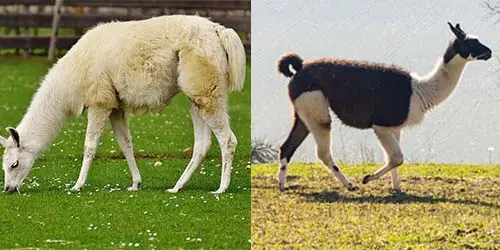Similar to many other animals, llamas do have tails. A llama’s tail is a flexible organ attached to the torso of the animal. It is made up of little pieces of bones connected by cartilage, covered with muscle tissue, skin, and fur.
A llama’s tail plays an important role in its everyday functioning. Llama uses the tail as an important tool of communication with its species.
Now that we answered the question “do llamas have tails”, let’s look into the tail appearance, its length, compare it to a tail of an alpaca, and explain what different positions of a llama’s tail mean.

What Does A Llama’s Tail Look Like?
A llama’s tail is a prolongation of its backbone beyond the trunk of the body. It is short and covered in hair. The tail has the same color as the fur of a llama: it can be black, white, brown, or gray. Healthy llamas have straight and fully functional tails.
Here’s a photo of the llama’s tail. Notice how the tail color matches the fur color.

Do Llamas Have Long Tails?
Llamas do not have long tails. Compared to their body size, llamas’ tails are short and furry. Llamas are from 3.9 to 7.2 ft long (1.2-2.2 m) and have a tail length between 6 and 12 inches (15-30 cm), depending on the animal’s sex, age, and size.
A llama’s tail should be long enough to cover the genital area and should be completely covered with fiber.
Compared to other animals, llamas do not have the longest of tails.
Llama’s close relatives, camels, have tails between 18 and 25.5 inches long (45-65 cm). This is two to three times longer than a tail of a llama.
Giraffes have tails between 30 and 95 inches long (76-240 cm). Compared to them, llamas have significantly shorter tails. This is normal, given that giraffes are a lot bigger animals than llamas.
Compared to their closest kin, the wild vicuna, llamas have slightly longer tails. Vicuna has a tail between 6 and 10 inches long (10-25 cm); llama’s tail is around 2 inches longer (5 cm).
The wild guanaco has a similar tail size to a vicuna, between 6 and 10.5 inches (10-27 cm). This is shorter than a llama’s tail.
Further reading: All animals that look like llamas (with pics)
Llama Vs Alpaca Tail
Llamas and alpacas are the only two domesticated South American camelids. They can be distinguished from one another by their size, fur length, ear shape, and their tail size and position. Llamas are bigger than alpacas and have banana-shaped ears.
Alpaca’s tail length ranges from 6 to 10 inches (15 and 25 cm). This is around 2 inches (5 cm) shorter than the tail of a llama which is 6-12 inches long (15-30 cm).
The main difference between the llama’s and alpaca’s tails is in their position. A llama might hold its tail high in the air when walking; the alpaca does not raise its tail.
| Animal | Tail Length |
| Llama | 6-12 in (15-30 cm) |
| Alpaca | 6-10 in (15 and 25 cm) |
| Vicuna | 6-10 in (15 and 25 cm) |
| Guanaco | 6-10.6 in (15 and 27 cm) |
| Camel | 18-25.5 in (45-65 cm) |
| Giraffe | 30-95 in (76-240 cm) |
As a comparison, they weigh 2 to 3 times as much as llamas; but moose have 3 times shorter tails than llamas.
What Does It Mean When A Llama Wags Its Tail?
As we mentioned before, llamas mostly use their tail to communicate with other llamas. Different tail positions can mean that a llama is alert, aroused, or submissive. Sometimes, a tail position can indicate disease in a llama.
A relaxed, non-aroused llama, will have a tail resting against its perineum. The higher the tail, the more aggressive a llama is.
An alert or somewhat aggressive llama will have a slightly elevated tail, but below horizontal. A more agitated llama will elevate its tail even higher and curl it horizontally or vertically.
If a tail is curled towards the animal’s back, that means that a llama is submissive.
When they notice incoming danger, a llama will make a high-pitched hum to alert the others. They will lift their tails up and move their ears forward, as a sign of increased alertness.

If a llama is waving its tail from one side to the other, that means that the animal might be slightly agitated. During copulation, a male will show excitement by wagging its tail and flip it up and down. When a female llama is wagging its tail in another llama’s face that means she is not interested in mating.
One of the signs of meconium impaction in baby llamas is tail wagging. If not treated, this progresses to anorexia, bloating, and abdominal discomfort.
Llama handlers should use ear and tail position as an indicator of the mental state of their llama. They should understand these signals to minimize stress for both animals and humans.
Llama Tail Disorders
The thick fur that covers the tail can often hide some clues about the tail.
There are several tail disorders in llamas: tail paralysis, crooked tail, tail deformation, etc. Damage or malfunction of nerves and muscles of the tail, mechanical interference with tail posture, congenital disorders (hereditary or non-hereditary), or different trauma to the tail can cause these disorders.
Different alpaca and llama associations and registries will not admit animals with crooked tails.
A llama with a tail deformity can make postures that convey wrong behavioral information. Disfigurement of the tail is sometimes considered unattractive.
In a 5-year-old study on disorders of camelids, 5.5% of examined llamas had crocked tails.
Are There Llamas Without Tails?
Sometimes, a llama might not have a tail. Different injuries and surgeries might require the removal of the tail. This makes it hard for a llama to use its tail as a means of communication with other animals.
Read More: Does a rhino have a tail?
Final Thoughts
This concludes our article going over the question “do llamas have tails”.
Llamas do have tails. Their tails are short and furry and llamas use them to communicate with other llamas. Llama’s tail is 6-12 inches long (15-30 cm); it is slightly longer than the alpaca’s tail. A llama will wag its tail when excited, if not interested in mating, or if it has some disease.
Interested in learning more about diseases llamas have? Here’s an article about llama’s digestive system and its disorders.
References
[1] Fowler, Murray. Medicine and surgery of camelids. John Wiley & Sons, 2011.
[2] Jost, Stéphanie Mali, et al. “Prevalence of coat color traits and congenital disorders of South American camelids in Austria, Germany, and Switzerland.” Acta Veterinaria Scandinavica 62.1 (2020): 1-8.
[3] Cebra, Chris, et al. Llama and alpaca care. Elsevier Health Sciences, 2014.